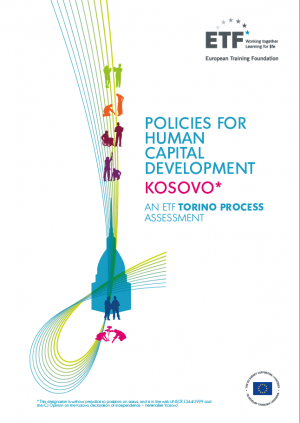The total population in Kosovo grew from 1 778 000 in 2016 to 1 791 000 in 2017 – or by 0.7%. Simultaneously, the working-age population (15+ years old) increased by 2.6% (from 1 276 000 in 2016 to 1 310 000 in 2017) and another 3.5% (to 1 358 000) in the first quarter of 2018 (WB/wiiw, 2019, p. 84). The working-age population is expected to continuously grow over the next decade. Every year, many young people enter the labour market for the first time and face difficulties finding employment.
However, recent demographic developments and a population projection until 2061 by the Kosovo Agency of Statistics (KAS) (Kastrati et al., 2017) show a major demographic decline over the mid to long term.
In the period from 2011 to 2016, the number of births steadily fell, from 34 569 in 2011 to 29 290 in 2015 (and slightly increasing again to 29 428 in 2016).
Table 1: Number of births and total fertility rate (TFR), 2011–2016
|
Year |
2011 |
2012 |
2013 |
2014 |
2015 |
2016 |
|
Births |
34.569 |
34.643 |
32.528 |
32.067 |
29.290 |
29.428 |
|
TFR |
2.41 |
2.40 |
2.25 |
2.23 |
2.07 |
2.10 |
Source: Kastrati et al., 2017, p. 13
Dissatisfaction with socio-economic conditions and the lack of employment opportunities are fuelling emigration. Migration by Kosovars to Western Europe, both legal and illegal, is quite widespread (Pupovci, 2019). The International Organisation for Migration (IOM) notes that one of the reasons for migration is the lack of confidence in the future of the country and its economy, especially among Albanian Kosovars with higher levels of education (IOM, 2017). In most cases people return only when they are denied residence (Pupovci, 2019). IOM also assists migrants from Kosovo with voluntary return and reintegration programmes.
Net migration data reflects the high emigration flows, especially during the turbulent years of 2014 to 2015. Emigration data used in the projection (Kastrati et al., 2017) is that received from the four main destination countries: Germany, Italy, Sweden and Switzerland.
Table 2: Net migration according to KAS harmonisation of data, 2011–2016
|
Year |
2011 |
2012 |
2013 |
2014 |
2015 |
2016 |
|
Harmonisation |
-6.076 |
-5.725 |
-16.382 |
-39.609 |
-55.572 |
-8.940 |
Source: Kastrati et al., 2017, p. 18
It is males in particular who leave Kosovo, reversing a trend from before 2011: new data included 62.7% males and 37.3% females (ibid.). Migration is highest for those aged 20 to 30, reaching a peak at 25 years of age; thereafter, this number decreases steadily to negligent numbers beyond the age of 55 (ibid., p. 19).
KAS's projections for ten-year periods until 2061, as shown in Table 3, use a 'medium variant' scenario that implies continuously declining birth rates and an assumed net migration of 10 000 people per year. However, the latter figure may well be higher. Anecdotal evidence suggests that emigration trends will remain significant. According to a survey conducted by the United Nations Development Programme (UNDP) in 2018, 'almost 60% of the young respondents consider leaving Kosovo in the next three years' (UNDP Kosovo, 2018, p. 5). At the time of writing this report, the Kosovo Parliament discussed the 'mass exodus' of young people and their families (Begisholli, 2019).
Table 3: Kosovo population by age groups and year, 2017–2061 (medium variant)
|
Year |
Population by age group |
|||
|
Total |
0–14 |
15–64 |
65+ |
|
|
2017 |
1.783.531 |
446.633 |
1.192.181 |
144.718 |
|
2021 |
1.809.458 |
431.526 |
1.211.592 |
166.341 |
|
2031 |
1.818.674 |
364.294 |
1.217.592 |
236.787 |
|
2041 |
1.759.492 |
290.436 |
1.150.779 |
318.277 |
|
2051 |
1.652.090 |
247.855 |
1.034.147 |
370.088 |
|
2061 |
1.492.192 |
199.518 |
892.803 |
399.871 |
Source: Kastrati et al., 2017, p. 21
Tables 4a and 4b show demographic trends for young people at the ages of 6, 15 and 19 years, which represent key transition points in education and to the labour market.
Table 4a: Kosovo population at ages 6, 15 and 19, 2017–2024 (medium variant)
|
Age |
2017 |
2018 |
2019 |
2020 |
2021 |
2022 |
2023 |
2024 |
|
6 |
28.458 |
32.184↑ |
32.088↓ |
30.093 |
29.905 |
27.721 |
28.404↑ |
27.728↓ |
|
15 |
34.191 |
32.125↓ |
29.679 |
29.703 |
28.514 |
27.599 |
27.670 |
27.982 |
|
19 |
32.050 |
31.944 |
31.189 |
40.885↑ |
33.773↓ |
31.893 |
29.416 |
29.391 |
Table 4b: Kosovo population at ages 6, 15 and 19, 2031–2061 (medium variant)
|
Age |
2031 |
2041 |
2051 |
2061 |
|
6 |
23.674 |
18.696 |
16.311 |
12.857 |
|
15 |
27.150 |
22.467 |
17.877 |
15.463 |
|
19 |
31.094 ↑ |
24.819↓ |
18.680 |
16.390 |
Tables 4a and 4b show that the number of children at the age of six enrolling in first grade is projected to shrink from 32 184 in 2018 to 28 404 in 2023, i.e. by 3 780 (or 11.7%) in only five years. Data for children at the age of 15 who enter upper secondary education is expected to fall even more rapidly – from 32 125 in 2018 to 27 670 in 2023, i.e. by 4 455 (or 13.9%). These trends will be reinforced in the years thereafter.
In contrast, the number of 19-year-olds who we assume to enter the labour market for the first time does not show marked differences between 2017 (32 050) and 2022 (31 893). However, a sharp, one-off rise is expected for 2020 (40 885), while numbers begin to fall slowly but continuously after 2022 (with another peak in 2031).
